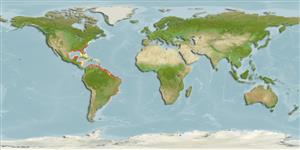>
Siluriformes (Catfishes) >
Ariidae (Sea catfishes) > Bagreinae
Etymology: Bagre: Mozarabic, bagre, taken from Greek, pagros = a fish (Dentex sp.) (Ref. 45335).
More on author: Mitchill.
Environment: milieu / climate zone / depth range / distribution range
Ecología
marino; salobre demersal; rango de profundidad 0 - 50 m (Ref. 5217). Subtropical; 43°N - 34°S, 98°W - 34°W
Western Atlantic: coast of Gulf of Mexico, Cuba, western margin of the Caribbean, and the northern margin of South America. Sometimes in rivers and estuaries.
Length at first maturity / Tamaño / Peso / Age
Maturity: Lm 44.8, range 50 - 63.5 cm
Max length : 69.0 cm TL macho / no sexado; (Ref. 40637); common length : 50.0 cm TL macho / no sexado; (Ref. 3265); peso máximo publicado: 4.4 kg (Ref. 40637)
Radios blandos anales: 22 - 28. Maxillary barbels, first ray of dorsal fin, and first ray of pectoral fin extended as long, flat filaments. 1 pair of barbels on chin.
Mainly marine but enters brackish estuaries with relatively high salinities (Ref. 5217). Opportunistic feeders over mud and sandy bottoms (Ref. 27549). Feeds mainly on small fishes and invertebrates. The dorsal and pectoral fins are equipped with a serrated erectile spine, both of which are venomous. Commonly caught by anglers along bridges, piers and catwalks. Flesh considered good; marketed fresh (Ref. 5217). Minimum depth reported taken from Ref. 57178.
Each male carries not more than 50 eggs in its mouth, usually averaging from 15 to 30 (Ref. 205).
Robins, C.R. and G.C. Ray, 1986. A field guide to Atlantic coast fishes of North America. Houghton Mifflin Company, Boston, U.S.A. 354 p. (Ref. 7251)
IUCN Red List Status (Ref. 130435)
Human uses
Pesquerías: comercial; pesca deportiva: si
Más información
ReferenciasAcuiculturaPerfil de acuiculturaRazasGenéticaElectrophoresesheritabilidadEnfermedadesProcesamientoNutrientsMass conversion
Herramientas
Special reports
Download XML
Fuentes de Internet
Estimates based on models
Preferred temperature (Ref.
123201): 22.7 - 27.9, mean 24.9 °C (based on 426 cells).
Phylogenetic diversity index (Ref.
82804): PD
50 = 0.5625 [Uniqueness, from 0.5 = low to 2.0 = high].
Bayesian length-weight: a=0.00562 (0.00324 - 0.00975), b=3.16 (3.00 - 3.32), in cm total length, based on LWR estimates for this species & (Sub)family-body (Ref.
93245).
Nivel trófico (Ref.
69278): 3.5 ±0.5 se; based on diet studies.
Resiliencia (Ref.
120179): Bajo, población duplicada en un tiempo mínimo de 4.5-14 años (Fec = 70).
Fishing Vulnerability (Ref.
59153): Moderate to high vulnerability (48 of 100).
Nutrients (Ref.
124155): Calcium = 61.8 [31.7, 152.9] mg/100g; Iron = 0.914 [0.564, 1.529] mg/100g; Protein = 17.6 [16.0, 19.4] %; Omega3 = 0.239 [0.137, 0.409] g/100g; Selenium = 29.5 [15.8, 59.0] μg/100g; VitaminA = 10.4 [4.4, 24.8] μg/100g; Zinc = 0.855 [0.571, 1.300] mg/100g (wet weight);
